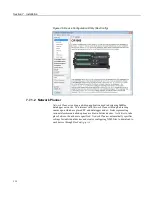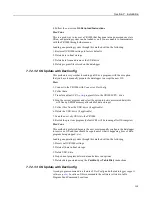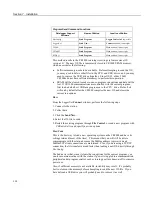
Section 7. Installation
7.8.2 Writing and Editing Programs
7.8.2.1 Short Cut Programming Wizard
Short Cut
is easy-to-use, menu-driven software that presents lists of predefined
measurement, processing, and control algorithms from which to choose. You
make choices, and
Short Cut
writes the CRBasic code required to perform the
tasks.
Short Cut
creates a wiring diagram to simplify connection of sensors and
external devices.
Quickstart Tutorial
(p. 41)
works through a measurement example
using
Short Cut
.
For many complex applications,
Short Cut
is still a good place to start. When as
much information as possible is entered,
Short Cut
will create a program template
from which to work, already formatted with most of the proper structure,
measurement routines, and variables. The program can then be edited further
using
CRBasic Program Editor
.
7.8.2.2 CRBasic Editor
CR1000 application programs are written in a variation of BASIC (Beginner's
All-purpose Symbolic Instruction Code) computer language, CRBasic (Campbell
Recorder BASIC).
CRBasic Editor
is a text editor that facilitates creation and
modification of the ASCII text file that constitutes the CR1000 application
program.
CRBasic Editor
is a component of
LoggerNet
(p. 655),
RTDAQ
,
and
PC400
datalogger support software
(p. 95).
Fundamental elements of CRBasic include the following:
•
Variables — named packets of CR1000 memory into which are stored values
that normally vary during program execution. Values are typically the result
of measurements and processing. Variables are given an alphanumeric name
and can be dimensioned into arrays of related data.
•
Constants — discrete packets of CR1000 memory into which are stored
specific values that do not vary during program executions. Constants are
given alphanumeric names and assigned values at the beginning declarations
of a CRBasic program.
Note
Keywords and predefined constants are reserved for internal CR1000 use. If
a user-programmed variable happens to be a keyword or predefined constant, a
runtime or compile error will occur. To correct the error, simply change the
variable name by adding or deleting one or more letters, numbers, or the
underscore (_) from the variable name, then recompile and resend the program.
CRBasic Editor Help
provides a list of keywords and predefined constants.
•
Common instructions — instructions (called "commands" in BASIC) and
operators used in most BASIC languages, including program control
statements, and logic and mathematical operators.
•
Special instructions — instructions (commands) unique to CRBasic,
including measurement instructions, and processing instructions that
compress many common calculations used in CR1000 dataloggers.
These four elements must be properly placed within the program structure.
125
Summary of Contents for CR1000
Page 2: ......
Page 4: ......
Page 6: ......
Page 32: ......
Page 36: ......
Page 38: ......
Page 40: ......
Page 60: ...Section 4 System Quickstart Figure 16 PC200W View Line Graph 60 ...
Page 96: ......
Page 98: ...98 ...
Page 302: ......
Page 453: ...Section 8 Operation Figure 115 Using the Keyboard Display 453 ...
Page 456: ...Section 8 Operation Figure 118 Real Time Custom 456 ...
Page 457: ...Section 8 Operation 8 8 1 3 Final Memory Tables Figure 119 Final Memory Tables 457 ...
Page 458: ...Section 8 Operation 8 8 2 Run Stop Program Figure 120 Run Stop Program 458 ...
Page 460: ...Section 8 Operation Figure 122 File Edit 460 ...
Page 461: ...Section 8 Operation 8 8 4 PCCard Memory Card Display Figure 123 PCCard CF Card Display 461 ...
Page 478: ......
Page 506: ......
Page 536: ......
Page 636: ......
Page 642: ......
Page 644: ......
Page 676: ......
Page 677: ......















































